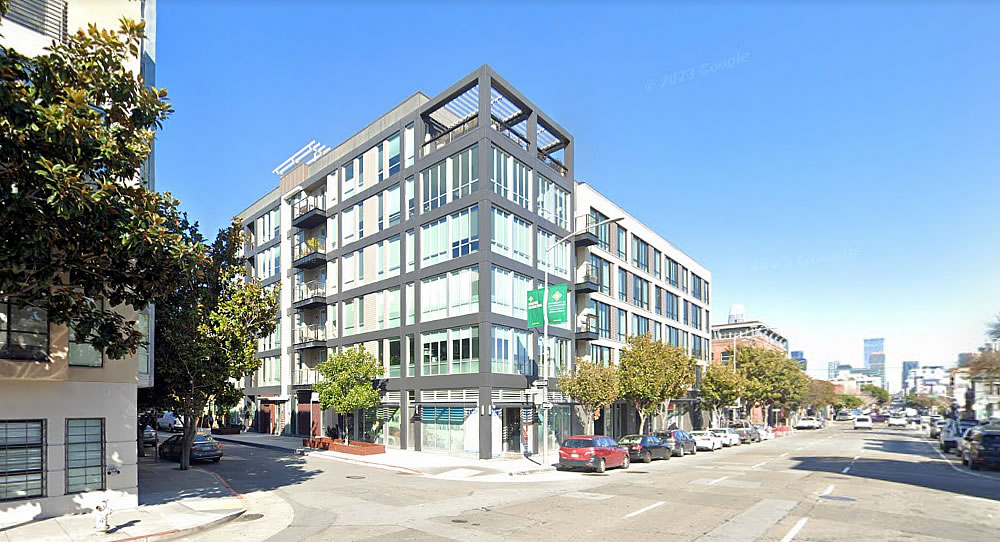As we outlined last year, the 624-square-foot, one-bedroom unit #502 at 99 Rausch, which was purchased for $880,000 in May of 2019, establishing a new “comp” for other neighborhood sales and valuations at $1,410 per square foot, had returned to the market listed for $650,000, aiming for an “over asking!” sale.
Withdrawn from the MLS and then listed anew with an official “1 day on the market” and a further reduced list price of $599,000 this past September, a sale at which would have been “at asking!” according to all industry stats and “hot market” reports, but would have represented a 32 percent drop in value on an apples-to-apples basis, the Western SoMa condo was then withdrawn again.
And having just been listed anew for $538,000, an “at asking!” sale for 99 Rausch Street #502 in this “surging” market would now represent a net 38.9 percent drop in value for the contemporary condo on an apples-to-apples basis over the past five years. If you think you know the market for modern SoMa condos and comp(arable) buildings and units, here’s another chance to tell.





$541K
$499
Credit to Brahma for accurately forecasting that this unit wouldn’t close in the two months following the May 2023 price reduction, and that the listing would be removed from the MLS thereafter. Although at the time, he said his valuation was just above the $604.5k level, which means he was almost 12 percent off the mark, if the current listing price isn’t another “low ball asking to incite bidding war” gambit.
$484,000
The current list for this unit still works out to over $860 per ft.². But all an interested buyer would need to do is look ¾ of a block away (and on a higher-located floor) at 1160 Mission St. Apt 802, a (larger) 764 ft.² 1 bedroom, 1 bathroom unit at Soma Grand, which last sold in late March 2018 for $1,082 per ft.² and has been listed on and off since March of this year, most recently for $798 per ft.² and is also available for lease at $3,800 per month. I assume the rental option is available so that the owner can avoid having to realize a (more than) 30 percent capital loss.
A corresponding value for 99 Rausch St., Unit 502 would be $497,950, which is where I’ll place my marker (if this closes in the next fourty-five days, which I don’t think is likely.)
A 2 bedroom on the 5th floor with parking and storage just closed a few weeks ago at $800K.
I looked into buying a unit in this building recently, but ultimately passed. I had the listing agent check with the HOA and indeed there is a Rental Cap, with more than 20 owners currently on a waiting list to rent out their units here. One of the main perks of this building is easy freeway access. But unlike the 2 units that recently sold in 99 Rausch St, this particular 1 bedroom has no parking space, and parking spaces in this building are not cheap to rent. And besides that, it’s a rough neighborhood to go out without a car. There are regularly encampments right on Rausch Street and homeless even sometimes sleep in the building’s vestibules and rummage through the garbage and recycling, leaving it all over the sidewalk and street for others to clean up. This is going to be a pretty tough sell.
Or as we outlined last month, with respect to larger units in the building with deeded parking spaces: Contemporary Western SoMa Condo Trades Down Over 30 Percent. And keep in mind the vast majority of condo building’s have rental caps, without which it can be challenging to secure a mortgage.
That would be a new piece of valuable information, wouldn’t it? A report on which downtown condo buildings have a waiting list of owners trying to rent out their units, and how many owners are on it, would be an interesting market metric to read, especially if you had historical data available and could use meaningful statistical techniques to establish a trend. My first instinct is that it would indicate how much “pent up supply” is waiting in the wings from real estate “geniuses” who are trying to avoid selling into a down market, assuming that the HOA for the buildings in question set the rental caps using some kind of quantitative methodology in the first place.
The unintended side effects of text book theory urban planning and public policy in SF. The anti-car advocates who encourage approval of under-parked developments, and say residents should learn to live without car. The homeless advocates who claim its wrong to disturb urban campers in the alleys, and say residents should learn to accept the health and safety risks. Etc.
…or maybe the side effects of gentrification, deindustrialization, decades of waves of historic speculative asset bubbles, extreme income and wealth inequality, crony capitalism, financialized capitalism, corporate capture of government, class war…
Very challenging neighborhood these days.
Yes the rental cap is true. But the bigger issue with this building is ongoing sb800 repairs. It means near impossible to get any bank mortgage.
It is way past time for the residential construction industry generally, and the segment that builds most mid-rise condominium buildings in particular, to clean up its act and start taking construction quality seriously. If repairs are a big enough issue that it impacts re-sales years after completion, then the solution (obvious to me, as a layman) is to build buildings with substantially fewer defects in the first place.
is to build buildings with substantially fewer defects in the first place But then they wouldn’t be inexpensive…like they’ve always been. Well, either that or they’d need to make less profit. (Shudders!)
In defense of the building industry, tho – to the extent that it’s some monolith – older construction quality was never as great as people imagine it was, so you’re perhaps pursuing a chimera.
There’s no need to imagine it, there are plenty of old building still standing that can be inspected and compared to newer buildings. Though in no ways perfect, houses built prior to WWII tend to be better crafted than those after. The period between 1950 and 1980 yielded some of the flimsiest houses standing. I think what happened is mass production of houses was in its infancy after the war and it took a while to find the right balance between cheap+fast and durability. The main thing that newer houses have going for them is the building code which has incrementally made buildings safer though not necessarily long lasting.
You need to imagine it if you want to bolster the “”World is going to Hell in a handbasket” narrative. I think we also need to differentiate between “craftsmanship” and structural integrity; so wheras as the former might deal with how carefully someone matches up trim, or paints a room, the latter deals with things like the replacement of 1×12 diagonal sheathing with plywood. Yes there are fools and fraudsters who try to build a house with staples, but I still think an average new house is better built than one 75 years ago. (Don’t forget that the worst of the houses from 75 years ago probably aren’t around any more…at least not without rebuilding).
I’m talking about residential mid-rises like this 6-story, 112-unit condominium complex between 7th and 8th Street in the south of market neighborhood, not SFHs, whether mass produced or not.
And it doesn’t matter either way if “older construction quality was never as great as people imagine it was”; what I am talking about is the phenomenon where new construction buildings routinely have common, completely preventable construction defects present that the developer hopes residents don’t find and complain about before the the statute of limitations established by California Senate Bill No. 800 (2001-2002, which what I thought Michael was referring to above) time periods expire.
I guess the “then they wouldn’t be inexpensive” remark was sarcasm. The costs for units like this one are, in actuality, higher, but most of those costs will be hidden from the buyer until after the close and the HOA has to impose a special assessment to cover the costs of repair if they can’t force the developer to repair them, either via litigation or a settlement in arbitration. So there’s an asymmetry of information between the building developer and buyer of condos.
Sure, if the HOA has ongoing disputes with the developer, that fact will be disclosed to any potential buyer who makes an offer. But a better way to force accountability on the construction industry in general, and in the medium term get them to increase construction quality to reasonable levels, would be to have a State Agency collect, summarize and widely promulgate statistics on which builders get involved in the most after-construction lawsuits and/or arbitration. That would, over time, force bad contractors out of the industry as home warranty and insurance providers start charging them more, and more mortgage lenders avoid offering mortgages on their products.